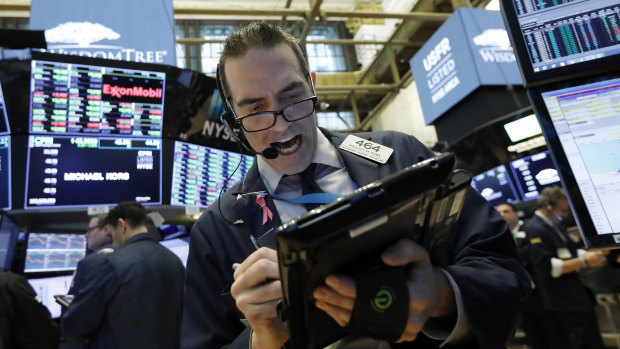This was published 3 years ago
Why markets don't seem to care if the economy stinks
By Barry Ritholtz
The stockmarket has been on a tear, yet the economy is in the dumps. So why do so many people believe - undoubtedly incorrectly - that the stockmarket has decoupled from reality?
The economy many people experience, while bleak, is local, personal and, for the most part, either not publicly traded or plays only a small part in the stockmarket's moves. To explain why these personal experiences have so little effect on equity markets, we must look more closely at the market role of the weakest industry sectors.

The US economy and Wall Street are going in different directions.Credit: AP
The surprising conclusion: The most visible and economically vulnerable industries are also among the smallest, based on their market-capitalisation weight in major indexes such as the S&P 500. Markets, it turns out, are not especially vulnerable to highly visible but relatively tiny industries. The 30 most economically damaged industry categories could be delisted before tomorrow's market open, and it would hardly shave more than a few percentage points off the S&P 500.
This is so despite the worst US economic collapse since the Great Depression. All of the economic data is so bad that figures on gross domestic product, unemployment and initial jobless claims must be re-scaled to even fit on charts.
But the US economy is not the stock market and vice versa. As we discussed before, ignoring overseas strength is a major oversight. The so-called FAANGs (along with Microsoft) derive about half - and in some cases even more - of their revenue from abroad. (Both before and especially since the pandemic, those six stocks have been the biggest drivers of the market-cap weighted indexes like the Nasdaq 100 or the S&P 500. If your only frame of reference is a domestic economy, this is easy to miss.)
Beyond that, the pandemic lockdown in the US has benefited the giant tech companies' sales and profits. No wonder the Nasdaq Composite 100 Index, which is dominated by big tech companies, is up about 26 per cent this year.
But a reasonable person might argue that GDP fell by about a third in the second quarter and the S&P 500 should be in sync with that. What's more, of the 500 companies in the S&P 500, about 450 of them are doing terribly. Industries such as retail, travel, energy, entertainment, dining have seen sales evaporate. Bankruptcies are piling up - legendary retailer Lord & Taylor is just the latest - and more are surely coming. Yet, the S&P 500, after a huge plunge in March, is up 2 per cent this year.
Market capitalisation explains why.
Start with some of 2020's worst-performing industries: Year-to-date (as of the end of July), these include department stores, down 62.6 per cent; airlines, off 55 per cent; travel services, down 51.4 per cent; oil and gas equipment and services, down 50.5 per cent; resorts and casinos, down 45.4 per cent; and hotel and motel real estate investment trusts, off 41.9 per cent. The next 15 industry sectors in the index are down between 30.5 per cent and 41.7 per cent. And that's four months after the market rebounded from the lows of late March.
These are highly visible industries, with companies that are well-covered by the news media with household names known to many consumers. Retailers are everywhere we go. Petrol stations, chain restaurants and hotels are ubiquitous in cities and suburbs across the country.
So although high visibility industries may be of considerable significance to the economy, they are not very significant to the capitalisation-weighted stock market indexes.
Consider how little these beaten-up sectors mentioned above affect the indexes. Department stores may have fallen 62.3 per cent, but on a market-cap basis they are a mere 0.01 per cent of the S&P 500. Airlines are larger, but not much: They weigh in at 0.18 per cent of the index. The story is the same for travel services, hotel and motel REITs, and resorts and casinos.
The market is telling us that these industries just don't matter very much to stockmarket performance. And the sectors that do matter? Consider just four industry group - internet content, software infrastructure, consumer electronics and internet retailers - account for more than $US8 trillion ($11.2 trillion) in market value, or almost a quarter of total US stockmarket value of about $US35 trillion. Take the 10 biggest technology companies in the S&P 500 and weight them equally, and they would be up more than 37 per cent for the year. Do the same for the next 490 names in the index, and they are down about 7.7 per cent. That shows just how much a few giants matter to the index.
On some level, it's completely understandable why many people believe that markets are no longer tethered to reality because the performance doesn't correspond to their personal experience, which is one of job loss, economic hardship and personal despair. But what's important to understand is that indexes based on market-cap weighting can be - as they are now - driven by the gains of just a handful of companies.
We can argue about whether the way the market reacts is good or bad and never reach a satisfying conclusion. But one thing the market isn't is irrational or disconnected from is the reality of market capitalisation, and its impact on stock indexes.
Ritholtz is a Bloomberg Opinion columnist. He is chairman and chief investment officer of Ritholtz Wealth Management, and was previously chief market strategist at Maxim Group. He is the author of "Bailout Nation."
Bloomberg
Market Recap
A concise wrap of the day on the markets, breaking business news and expert opinion delivered to your inbox each afternoon. Sign up for the Herald's here and The Age's here.